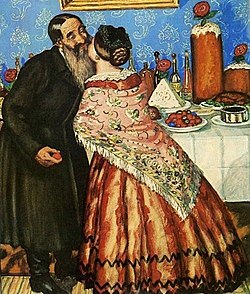Origem: Wikipédia, a enciclopédia livre.
(Redirecionado de
Domingo de Páscoa)
A
Páscoa (do
hebraico Pessach, significando
passagem através do
grego Πάσχα) é um evento religioso
cristão, normalmente considerado pelas igrejas ligadas a esta corrente religiosa como a maior e a mais importante festa da Cristandade. Na Páscoa os cristãos celebram a Ressurreição de
Jesus Cristo depois da sua morte por crucificação (ver
Sexta-Feira Santa) que teria ocorrido nesta época do ano em
30 ou
33 da
Era Comum. O termo pode referir-se também ao período do
ano canônico que dura cerca de dois meses, desde o domingo de Páscoa até ao
Pentecostes.
Os eventos da
Páscoa teriam ocorrido durante o
Pessach, data em que os
judeus comemoram a libertação e fuga de seu povo escravizado no Egito.
A palavra Páscoa advém, exatamente do nome em hebraico da festa judaica à qual a Páscoa cristã está intimamente ligada, não só pelo sentido simbólico de “passagem”, comum às celebrações pagãs (passagem do inverno para a primavera) e judaicas (da escravatura no Egito para a liberdade na Terra prometida), mas também pela posição da Páscoa no calendário, segundo os cálculos que se indicam a seguir.
A Páscoa cristã celebra a ressurreição de Jesus Cristo. Depois de morrer na cruz, seu corpo foi colocado em um sepulcro, onde ali permaneceu por três dias, até sua ressurreição. É o dia santo mais importante da religião cristã. Muitos costumes ligados ao período pascal originam-se dos festivais pagãos da primavera. Outros vêm da celebração do Pessach, ou Passover, a Páscoa judaica, que é uma das mais importantes festas do calendário judaico, celebrada por 8 dias e onde é comemorado o êxodo dos israelitas do Egito, da escravidão para a liberdade. Um ritual de passagem, assim como a "passagem" de Cristo, da morte para a vida.
A última ceia partilhada por Jesus Cristo e seus discípulos é narrada nos Evangelhos e é considerada, geralmente, um “
sêder do pesach” – a refeição ritual que acompanha a festividade judaica, se nos ativermos à cronologia proposta pelos
Evangelhos sinópticos. O
Evangelho de João propõe uma cronologia distinta, ao situar a morte de Cristo por altura da hecatombe dos cordeiros do Pessach. Assim, a última ceia teria ocorrido um pouco antes desta mesma festividade.
No português, como em muitas outras línguas, a palavra Páscoa origina-se do hebraico Pessach. Os espanhóis chamam a festa de Pascua, os italianos de Pasqua e os franceses de Pâques.
A festa tradicional associa a imagem do coelho, um símbolo de fertilidade, e ovos pintados com cores brilhantes, representando a luz solar, dados como presentes. De fato, para entender o significado da Páscoa cristã atual, é necessário voltar para a Idade Média e lembrar os antigos povos pagãos europeus que, nesta época do ano, homenageavam Ostera, ou Esther – em inglês, Easter quer dizer Páscoa. Ostera (ou Ostara) é a deusa da Primavera, que segura um ovo em sua mão e observa um coelho, símbolo da fertilidade, pulando alegremente em redor de seus pés nus. A deusa e o ovo que carrega são símbolos da chegada de uma nova vida. Ostara equivale, na mitologia grega, a Deméter. Na mitologia romana, é Ceres.
[1]
Os termos "Easter" (
Ishtar) e "Ostern" (em inglês e alemão, respectivamente) parecem não ter qualquer relação etimológica com o Pessach (Páscoa). As hipóteses mais aceitas relacionam os termos com
Estremonat, nome de um antigo mês germânico, ou de
Eostre, uma deusa germânica relacionada com a primavera que era homenageada todos os anos, no mês de Eostremonat, de acordo com o
Venerável Beda, historiador inglês do
século VII.
 Bolo de cenoura(25213 acessos)
Bolo de cenoura(25213 acessos)
 Bolo de chocolate molhadinho(18041 acessos)
Bolo de chocolate molhadinho(18041 acessos)
 Bolo gelado(9975 acessos)
Bolo gelado(9975 acessos)
 Bolo de fubá da vó Maria(8846 acessos)
Bolo de fubá da vó Maria(8846 acessos)
 Nega maluca(8200 acessos)
Nega maluca(8200 acessos)
 Bolo de fubá cremoso(7201 acessos)
Bolo de fubá cremoso(7201 acessos)
 Bolo brigadeiro de aniversário(6998 acessos)
Bolo brigadeiro de aniversário(6998 acessos)
 Bolo de banana(5998 acessos)
Bolo de banana(5998 acessos)
 Bolo de chocolate sem farinha(5815 acessos)
Bolo de chocolate sem farinha(5815 acessos)
 Torta de limão da Regina(5403 acessos)
Torta de limão da Regina(5403 acessos)






